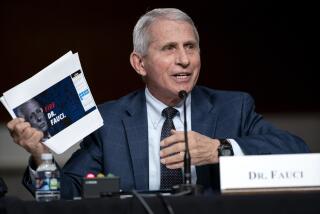Downsized to death
Last week, consumers were worried about salmonella in their fresh tomatoes. Before that, it was E. coli in their spinach. Something is wrong. Eating a salad is not supposed to be a high-risk activity
But the problem isn’t so much farmers. It’s ideology. Historian Rick Perlstein, author of “Nixonland,” calls it “E. coli conservatism” -- government shrinks and shrinks until people get sick.
“Government is not the solution to our problem,” President Reagan famously declared in his inaugural address in 1981. “Government is the problem.”
Many conservatives have gone far beyond that. Their traditional embrace of small government has been replaced with outright disdain for it. Grover Norquist, president of Americans for Tax Reform, doesn’t just want to shrink government. To use his words, he wants government “down to the size where we can drown it in the bathtub.”
Once in power, E. coli conservatives shrink government by hamstringing it. They weaken rules that protect people, slash the budgets of consumer agencies and appoint industry friends to oversight commissions. The result: Some government regulatory agencies that we trust to protect us have shrunk to insignificance or serve private industry rather than consumers.
The Food and Drug Administration’s seeming ineptness in finding the source of a salmonella outbreak, which has poisoned more than 1,200 people in 42 states, is case in point. What’s especially troubling is that even before this episode, the Government Accountability Office had officially designated “federal oversight of food safety as a high-risk area.”
The FDA first thought that tomatoes -- either grown in Florida or imported from Mexico -- were the culprit. After weeks of trying to trace the source of the salmonella, with domestic farmers bulldozing crops they weren’t allowed to sell and taking a $100-million hit, the agency on Thursday ruled out tomatoes. It’s now on the trail of jalapeno peppers.
What’s clear, though, is that imports of agricultural products have increased by 78% since 1973, but inspections of those products have decreased by 78% over the same period, according to the Coalition for a Stronger FDA, whose membership includes former chiefs of the Department of Health and Human Services, of which the FDA is a part. That’s a problem because the FDA itself says pesticide violations or infectious disease occur three times more often in imported foods than in domestic foods. In 1991, there were 1.5 inspections for each $1 million worth of imported agriculture commodities; in 2006 there were only 0.4.
In a 2007 interview in USA Today, William Hubbard, a former FDA associate commissioner, admitted that food safety had become a crap shoot: “The FDA has so few resources, all it can do is target high-risk things, give a pass to everything else and hope it is OK.
The agency’s decline started when Reagan was president. FDA food inspections plummeted from 29,355 in 1980 to 7,668 in 1989. They stayed flat during Bill Clinton’s years in the White House, then jumped past 11,000 after 9/11, amid fears that the nation’s food was vulnerable to terrorist attack. Food inspections have now, however, fallen to levels below that number.
But E. coli conservatism is not limited to the food supply. Before the salmonella outbreak, there were major recalls of pet food (contaminated by melamine) and toys (lead paint). The agency that’s supposed to protect us from toxic toys is the Consumer Product Safety Commission, a job made tougher because its resources have been cut. The commission’s 2007 budget was half its 1974 budget in real dollars. Staffing is in free fall, dropping from 978 in 1980 to 420 in 2007. The testing labs have not been modernized since 1975, and the 2008 budget request removed the reduction of childhood drowning deaths as a strategic goal because of “resource limitations.” The agency’s entire toy-testing department last year consisted of one man who dropped toys on his office floor to see if they broke.
People cannot test toys for lead on their own. That’s why Congress created the Consumer Product Safety Commission in 1972 “to protect the public against unreasonable risks of injury associated with consumer products” by giving the agency the authority to set safety standards, require labeling, order recalls, ban dangerous products and collect death and injury data. People count on it to do its job.
In the era of globalization, the job is more important than ever. When the commission was created, toys were primarily manufactured in the U.S. under American-set safety standards. Now they are mostly imported from low-wage producers in countries not subject to U.S. rules. The Toy Industry Assn. estimates that 80% of the toys that Americans buy are made in China. Last year, more than 20 million of them were recalled because of lead paint or other hazards. The U.S. banned the use of lead paint 30 years ago.
After the 2006 election, the new Democratic Congress recognized the dangers and offered additional resources. The commission chair, Nancy Nord, resisted. The appointee of President Bush, said fears about not protecting consumers were overstated and that modest oversight plus commercial self-interest were sufficient to achieve the agency’s goals.
There are many other examples of E. coli conservatism at work. In 2000-2001, energy deregulation in California opened the door for Enron and similar companies to artificially limit the supply of electricity to the state, driving up prices and creating rolling blackouts. Financial deregulation helped create the housing bubble by allowing companies to sell mortgages to people who couldn’t afford the payments. The surging commodities markets and the swooning stock markets are in part caused by rule changes, made in the name of deregulation, that make it easier to speculate on price swings. It was recently learned that the three main credit-rating agencies -- Standard & Poor’s, Moody’s Investors Service and Fitch Ratings -- failed to rein in conflicts of interest in their ratings practices. Among the problems: Companies issuing securities were paying the ratings agencies for their rating.
Enough. Instead of talking about the size of government, we should be debating how to make our government more effective. How many more people have to get sick before the government reclaims its mission to serve the people?
More to Read
Sign up for Essential California
The most important California stories and recommendations in your inbox every morning.
You may occasionally receive promotional content from the Los Angeles Times.










